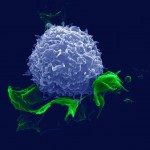Link to Pubmed [PMID] – 10424277
J. Hepatol. 1999 Jul;31(1):1-7
BACKGROUND/AIM: Fifty percent of patients infected with hepatitis C virus (HCV) show no response to alpha-interferon, and no alternative therapy has thus far proven to be effective. Therapeutic combination with ribavirin and alpha-interferon has shown promising results in naive patients and in relapsers, but based on limited series, it was reported to be inefficient in non-responders. The aim of our study was therefore to explore and compare, in a randomized trial, the tolerance and potential efficacy of alpha-interferon alone with a sequential combination of ribavirin and the same alpha-interferon regimen in those patients.
METHODS: Sixty-four non-responder patients were randomized in the alpha2b-interferon group (a 6-month course at a dosage of 6 MU followed by a 6-month course of 3 MU three times weekly subcutaneously) and 62 in the “combination” group (sequential combination of the same alpha2b-interferon therapy preceded by a 2-month course of ribavirin which was then associated for 2 months with alpha2b-interferon at a daily dosage of 1.0 or 1.2 g).
RESULTS: Treatment withdrawal was necessary for six patients from the alpha-interferon and eight patients from the combination group. Normalization of aminotransferase activities was significantly more frequent after the 4-month course of ribavirin with 2 months of interferon than after 2 months of interferon alone (52.8 vs. 26.2%, p<0.01), but this difference was not maintained after ribavirin withdrawal. Disappearance of serum HCV RNA (PCR) was significantly more frequent at the end of treatment in the combination group (24.5 vs. 7.7%, p=0.02), but did not differ 6 months after the end of therapy (9.8 and 8.3%, respectively). The long-term response was not associated with liver status (cirrhosis vs. absence of cirrhosis) or genotype. Mean viremia was significantly lower in long-term responders than in non-responders or relapsers in both groups (p<0.001 for the interferon group and p<0.05 for the combination group), but the large extent of viral load precluded reliable prediction. The pre- and post-treatment hepatitis activity index did not differ between the two groups. While a crude histopathological improvement in the hepatitis activity index for a given patient was more frequently observed in the combination group (69.2 vs. 35.9%, p<0.01), improvement as defined by a decrease of at least 2 in the hepatitis activity index was significant only for lobular necrosis and degeneration.
CONCLUSIONS: This study demonstrates the efficacy of the combination of ribavirin/alpha-interferon in non-responders. Indeed, (i) it is fairly tolerated; (ii) it increases the rate of the initial biological response, and of the virological response by decreasing breakthrough, though this benefit is not sustained; and (iii) it induces a significant histological improvement in necrosis. A simultaneous and prolonged combination of ribavirin/alpha-interferon should be further evaluated in non-responders.

